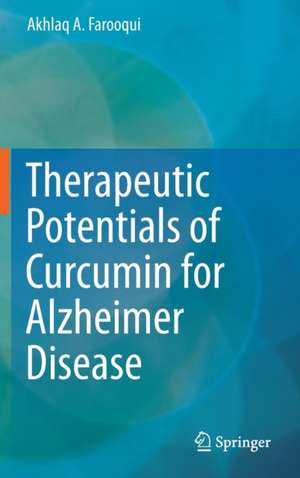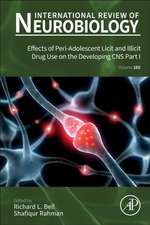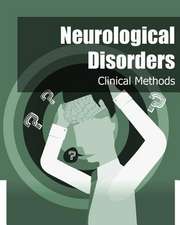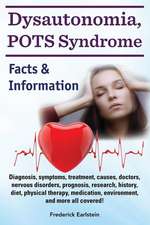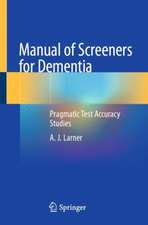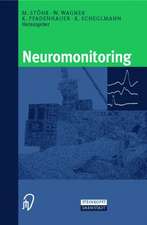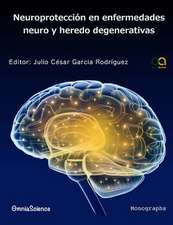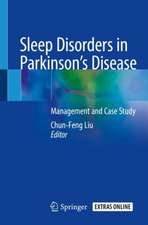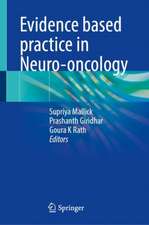Therapeutic Potentials of Curcumin for Alzheimer Disease
Autor Akhlaq A Farooquien Limba Engleză Hardback – 14 mar 2016
| Toate formatele și edițiile | Preț | Express |
|---|---|---|
| Paperback (1) | 950.52 lei 6-8 săpt. | |
| Springer International Publishing – 24 apr 2018 | 950.52 lei 6-8 săpt. | |
| Hardback (1) | 956.69 lei 6-8 săpt. | |
| Springer International Publishing – 14 mar 2016 | 956.69 lei 6-8 săpt. |
Preț: 956.69 lei
Preț vechi: 1166.69 lei
-18% Nou
Puncte Express: 1435
Preț estimativ în valută:
183.06€ • 190.67$ • 152.61£
183.06€ • 190.67$ • 152.61£
Carte tipărită la comandă
Livrare economică 28 martie-11 aprilie
Preluare comenzi: 021 569.72.76
Specificații
ISBN-13: 9783319158884
ISBN-10: 3319158880
Pagini: 375
Ilustrații: XIX, 402 p. 90 illus., 45 illus. in color.
Dimensiuni: 155 x 235 mm
Greutate: 0.77 kg
Ediția:1st ed. 2016
Editura: Springer International Publishing
Colecția Springer
Locul publicării:Cham, Switzerland
ISBN-10: 3319158880
Pagini: 375
Ilustrații: XIX, 402 p. 90 illus., 45 illus. in color.
Dimensiuni: 155 x 235 mm
Greutate: 0.77 kg
Ediția:1st ed. 2016
Editura: Springer International Publishing
Colecția Springer
Locul publicării:Cham, Switzerland
Public țintă
ResearchCuprins
Preface.- Effect of long term consumption of high calorie diet and calorie restriction on human health.- Neurochemical effects of long term consumption of high fat diet.- Neurochemical effects of long term consumption of simple carbohydrates.- Effects of long term consumption of animal proteins in the high calorie diet.- Effect of soft drink consumption on human health.- Contribution of salt in inducing biochemical changes in the brain.- Importance and roles of fiber in the diet.- Effects of the high calorie diet on the development of chronic visceral disease.- Effects of long term consumption of high calorie diet on neurological disorders.- Perspective and direction for future research: modification of high calorie diet needed for optimal health of human visceral and brain tissues.- Index.
Notă biografică
Akhlaq A. Farooqui is a leader in the field of signal transduction processes, lipid mediators, phospholipases A2, glutamate neurotoxicity, phytochemicals and human health and neurological disorders. He has published cutting edge research on the role of phospholipases A2 in signal transduction processes, generation and identification of lipid mediators during neurodegeneration by lipidomics and has studied the involvement of glycerophospholipid, sphingolipid and cholesterol-derived lipid mediators in kainic acid neurotoxicity, an experimental model of neurodegenerative diseases.
Textul de pe ultima copertă
Curcumin is a yellow–orange pigment obtained from the plant Curcuma longa. The powdered rhizome of this plant, called turmeric, is a common ingredient in curry powders and has a long history of use in traditional Asian medicine. Thus, curcumin has been used extensively in Ayurvedic medicine (Indian system of medicine) and Chinese traditional medicine for centuries as a antinociceptive, antiinflammatory, and antishock agent to relieve pain and inflammation. Epidemiological studies have revealed that in India, where dietary curcumin is consumed daily in the form of curry than in the United States, the morbidity rate attributed to Alzheimer disease (AD) for Indian elders (70–79 years old) is 4.4 times lower compared to the same age group of Americans. Furthermore, elderly healthy individuals who consume curry more frequently show better cognitive performance than senior who do not consume curry. Curcumin has been extensively investigated for treating AD over decades in animal model of AD, where curcumin crosses blood brain barrier and neural cell membranes and mediates its antioxidant, antiinflammatory, antiamyloidogenic , antiangiogenic, antiproliferative, antiapoptotic, metal chelating effects leading to retardation of signal transduction pathways associated with oxidative stress and neuroinflammation. Thus, curcumin fulfills the characteristics for an ideal neuroprotective agent for AD with its low toxicity, affordability, and easy accessibility. However, poor bioavailability of curcumin is the major hurdle for its more widespread use in animals and humans. The bioavailability of curcumin can be increased by encapsulation of curcumin into liposomes, cyclodextrin, curcumin conjugate with PLGA, complexation with phospholipids, and synthesis of curcumin analogs. This monograph is the first to describe neurochemical potentials of curcumin for the treatment of AD.
Caracteristici
Provides current and comprehensive information on the effects of curcumin in a brain affected by Alzheimers disease Explores a unique topic in the field of neurochemistry and neuroscience Explores the relation of signal transduction processes to the pathogenesis of Alzheimer's Disease and modulation of pathogenic changes by curcumin Includes supplementary material: sn.pub/extras
